Intel Core i7-6950X Broadwell-E Review
Intel’s new CPU has 10 cores, 20 threads, and costs over $1,700. We put it through 23 benchmarks to see if it’s worth it.
Let’s just get this right out of the way: Intel’s new 10-core, 20-thread Core i7-6950X Broadwell-E CPU is not for your average PC gamer. At $1,723, this “enthusiast” SKU processor is not even for your typical enthusiast. The 6950X is a prosumer chip, with a special emphasis on the prefix “pro.”
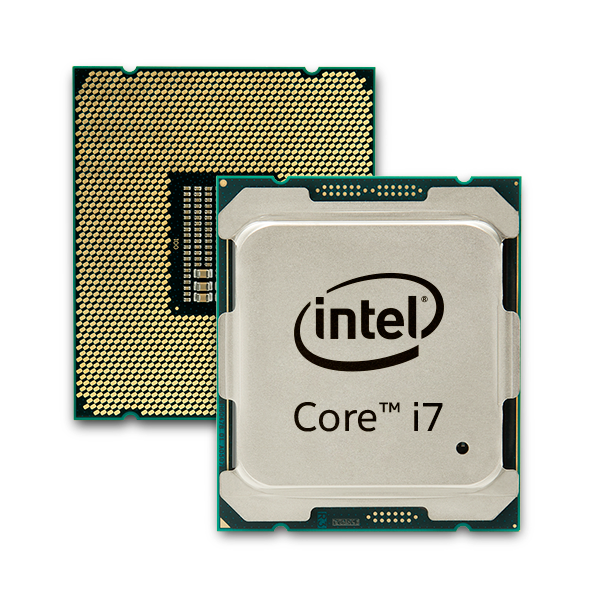
The 6950X is a prosumer chip ...with a special emphasis on the prefix “pro.”
Yes, it’s a really good processor for gaming, but there are CPUs out there that are slightly better for your general gaming needs that cost considerably less. But why pay more, you ask? The 6950X isn’t just for playing games, but it excels at game development.
Essentially, you get a better bang for your buck out of the chip with productivity tasks like 3D rendering, encoding, and what Intel is calling “megatasking.” What is megatasking? Unlike multitasking, which is doing a bunch of unrelated tasks at the same time, megatasking is doing a bunch of workload-related events in tandem with each other. A professional Twitch streamer is someone who might do a lot of megatasking, when they’re playing a game, managing a chat client, processing audio, live streaming with a web camera, capturing and transcoding video, and processing a green screen. As all these events are happening at the same time, this can be very computationally intensive. There are companies that even make rigs with two CPUs to divvy up these tasks for pro streamers. With the 6950X, Intel aims to give them enough juice to do everything with a single chip.
Pro streamer aside, the 6950X is for those who want to work during the day, but also want to game at night. But buying the 6950X just for gaming is like purchasing a tank for your everyday commute. If all you’re looking to do is get to work on time, something like a sedan (or quad-core CPU) will be much more economical.
Intel claims that its first consumer 10-core CPU is up to 35 percent faster in multi-threaded applications compared to the company’s former enthusiast flagship CPU, which was 2014’s 8-core 5960X Haswell-E processor. Intel also says the 6950X is up to two times as fast as its leading quad-core 6700K CPU, which came out late last year, in multi-threaded applications. In my review here, I’ll be benchmarking all three chips against each other to put Intel’s claims to the test.
Broadwell-E SKUs
The 6950X is but the highest-end SKU in Intel’s new enthusiast CPU lineup. Broadwell-E encapsulates a total of four chips that include the 6950X ($1,723), 6900K($1089), 6850K($617), and 6800K ($434).
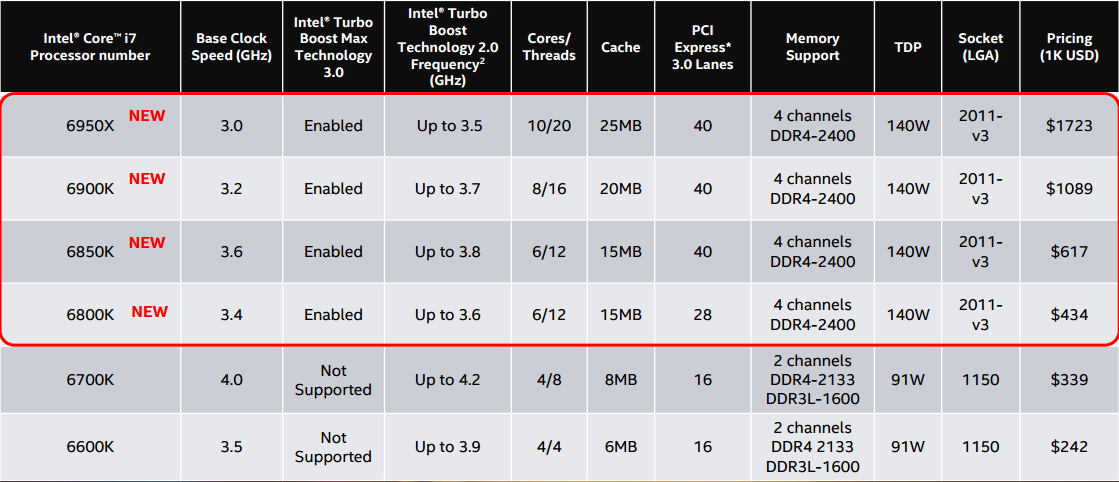
Really, when you look at the chart above, you’ll see that the 6900K is really the CPU to supplant the 5960X. Not only are both chips in the $1,000 range, but both are octo-core processors that have 16 threads and offer 20MB of L3 cache. This puts the $1,723 6950X in a new price and performance category we’ve yet to see from Intel before. It’s almost a Core i9, if you will.
There are corollary chips to the rest of Intel’s Haswell-E lineup, however. The six-core Broadwell-E 6850K supplants the Haswell-E 5930K and the six-core Broadwell-E 6800K supplants the six-core Haswell-E 5820K, with both offering a fettered 28 PCI-Express 3.0 lanes (down from the 40 lanes that the rest of the SKUs offer). Regardless of cores and lane counts, all Broadwell-E CPUs have a 140-watt thermal design power (TDP).
Broadwell-E represents Intel’s first foray at delivering a 10-core CPU for the consumer market. While more cores is great for applications that can take advantage of them, many programs don’t effectively use more than four-cores (games, I’m looking at you). This can be problematic considering that the constraints of physics dictate that the more cores you put on a CPU die, the less you can push their frequencies (speeds). This is primarily a problem with heat and power. Conversely, this means that CPUs with less cores can often get away with running faster frequencies, since the CPU die is less crowded (and less hot). What this means is that for single-threaded tasks or applications that don’t take advantage of more than four cores, a quad-core CPU with faster cores will be able to outperform an eight or 10-core CPU with slower cores. With that said, Intel does have some supposed workarounds to help mitigate these issues with Broadwell-E, which we’ll get to in a bit.
Architecture
The 6950X is based off of Intel’s 14nm Tri-Gate 3D Broadwell micro-architecture, which uses a more compact lithography compared to Intel’s previous 22nm Haswell architecture. Those with one foot in the PC hardware scene might be wondering, “Why Broadwell? Isn’t Skylake the newer architecture?” Yes, Skylake is Intel’s newer architecture, but it makes sense that we’re getting Broadwell-E before Skylake-E.
This puts the $1,723 6950X in a new price and performance category we’ve yet to see from Intel before. It’s almost a Core i9, if you will.
Rumor has it that Broadwell’s non-enthusiast CPUs (the consumer quad-core chips that released last year) ran into some internal issues, which caused them to launch behind schedule. It is worth mentioning that Broadwell wasn’t originally meant to be a socketed CPU, meaning it would be embedded onto motherboards. That ended up not being the case, however. When consumer Broadwell did finally come out late last year, it only took a handful of weeks for Intel’s Skylake architecture to catch up and release right at the tail end of Broadwell’s launch, supplanting it in the consumer quad-core market. Since Intel’s enthusiast line of CPUs are based on server chips and always lag behind their consumer parts, Broadwell-E and Skylake-E aren’t beholden to the same timeline.
As mentioned, Broadwell-E is based on a server chip, the 10-core 6950X is basically a stripped-down Intel Xeon processor. Unlike Xeon chips, however, prosumer Broadwell-E processors are fully unlocked, meaning you can overclock them.
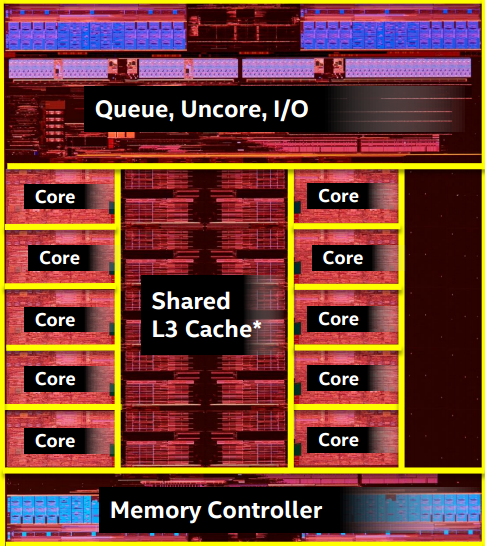
Looking at the die shot above, we can see the features like I/O in the upper third. Beneath that we see the 10 physical CPU cores with 25MB of shared L3 cache in between. On the bottom we see the memory controller. And the blank vertical rectangle on the right? Well, it’s just empty. Normally, in a Xeon chip, it would have additional bits that would be important for server-based applications, but since this isn’t a server chip, Intel decided to just leave it empty.
In terms of 6950X specs, we’re looking at a 3GHz base frequency and a 3.5GHz turbo frequency. This is similar to the eight-core 5960X Haswell-E CPU before it. As a matter of fact, Broadwell-E features a lot of similarities to 2014’s Haswell-E. Both chips support quad-channel memory and are available in unlocked variants, but neither one offers integrated graphics or comes packaged with a CPU cooler. Why don’t either of them feature integrated graphics? Essentially, since they are enthusiast SKUs, Intel figures that you’ll be running a more powerful, dedicated graphics card with it. And why the lack of a cooler? Again, with these being enthusiast CPUs, Intel figures you’ll be sticking a more premium water cooler on the chip. Both CPUs also use the X99 chipset and LGA 2011v3 motherboard socket (not to be confused with LGA 2011, which is a completely different socket), though, if you intend to use an existing X99 motherboard, you’ll need to update your motherboard’s BIOS for Broadwell-E. Finally, like the Haswell-E 5960X, the Broadwell-E 6950X supports 40 PCI-Express lanes, which is just enough if you want to run four graphics cards in your system. Since new, super-fast solid-state drives work off the NVMe protocol, which takes up additional PCI-E lane, however, I would have liked to have seen more than 40 lanes, considering we’ve been stuck with 40 lanes since 2011 (coincidentally both the year and the socket). Yes, not many people will want to run four video cards a long with an NVMe SSD, but then again, most people don't buy $1,700 processors either. Intel says the lane increase is primarily held back by the LGA 2011v3 socket, so that’s a price you pay for backwards compatibility.
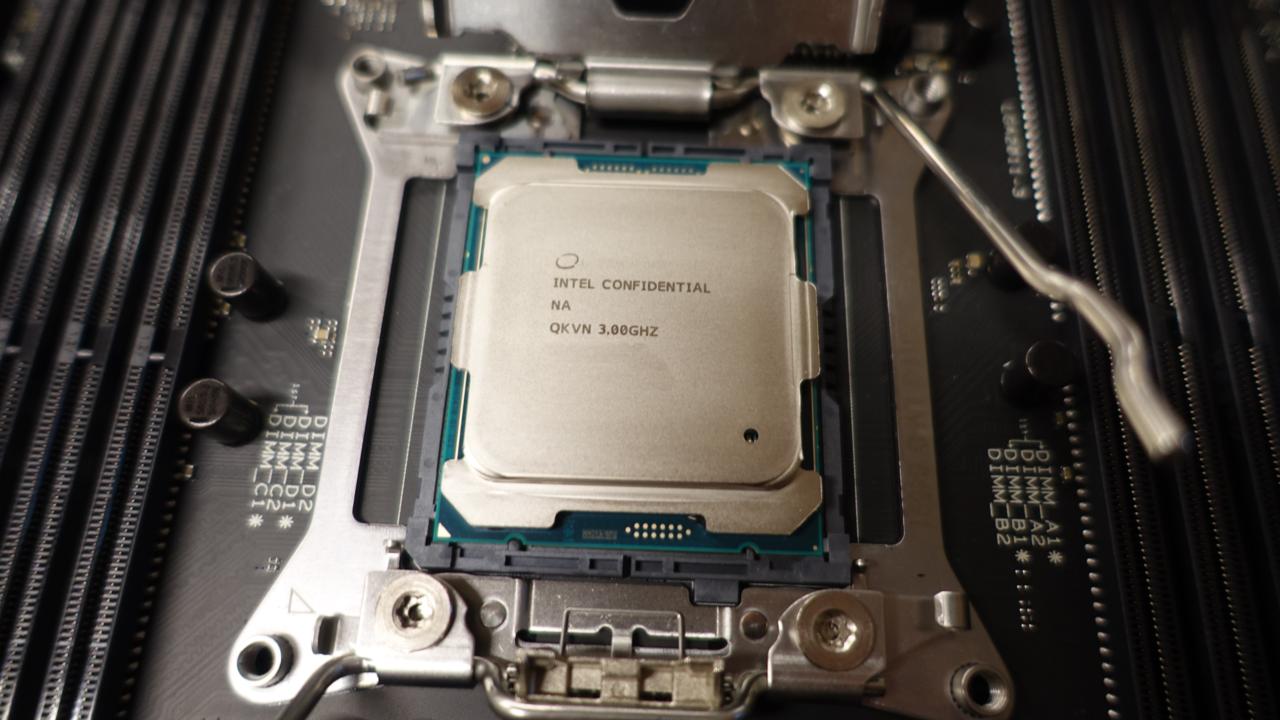
While Broadwell-E shares a lot of similarities to its predecessor, there are a number of key changes. Specifically in regards to the 6950X, it features a large 25MB of L3 Cache on the CPU, which is 5MB more than the 5960X’s offering. Broadwell-E also officially supports 2400MHz DDR4 RAM right out of the box, which is up from 2133MHz compared to Haswell-E. Broadwell-E also has support for Thunderbolt 3.0, some new overclocking features, and Intel’s new Turbo Boost Max 3.0.
The CPU-savvy here might have heard of Intel’s Turbo Boost 2.0, which temporarily and intelligently boosts a CPU’s cores to run faster than the base frequency under load. While Turbo Boost 2.0 is still present in Broadwell-E, the issue here is that some tasks, like Adobe Photoshop or gaming, will often only intensively use one core. So rather than boosting multiple cores, with Turbo Boost Max 3.0, Broadwell-E can automatically detect which is the fastest core out of the bunch, designate it to the task at hand, and boost that single core by up to 15 percent. This effectively brings a CPU core running at 3.5GHz up to 4GHz. This is how Intel hopes to level the playing field between the relative slow frequency of the 6950X against CPUs that have fewer, but faster cores.
It is worth mentioning that to get Turbo Boost Max 3.0 working on our setup, we had to download a driver to get it working. Intel tells me it is working with Microsoft to try and roll it into a Windows update sometime in the future.
Benchmarks
Methodology
To put the 6950X through its paces, I’m testing it against the octo-core 5960X and Intel’s leading consumer quad-core 6700K using two testbeds that I built. The specs of each system are in the chart below.
| Broadwell-E | Haswell-E | Skylake | |
| CPU | Intel Core i7-6950X | Intel Core i7-5960X | Intel Core i7-6700K |
| Motherboard | Asus Strix X99 Gaming | Asus Strix X99 Gaming | Gigabyte GA-170X-Gaming 7 |
| RAM | Corsair Vengeance 2133MHz | Corsair Vengeance 2133MHz | Corsair Vengeance 2133MHz |
| GPU | GeForce GTX 980 | GeForce GTX 980 | GeForce GTX 980 |
| SSD | Corsair Force LS 240GB | Corsair Force LS 240GB | Seagate 600 Series 240GB |
| HDD | WD 2TB | WD 2TB | Seagate 2TB |
| Cooler | Corsair H115i | Corsair H115i | NZXT Kraken X61 |
| Case | Corsair Carbide 600C | Corsair Carbide 600C | NZXT H440 |
| OS | Windows 10 | Windows 10 | Windows 10 |
| PSU | Corsair RM850X | Corsair RM850X | NZXT 1200W |
Since Broadwell-E and Haswell-E both use the X99 chipset, I tested them using the same system. I first ran the benchmarks on the 6950X and then swapped the 5960X in its place. Since Intel’s leading 6700K quad-core CPU uses the LGA 1151 socket, it requires a completely different setup. Regardless, all configurations use 16GB of Corsair Vengeance RAM clocked at 2133MHz, a GeForce GTX 980 graphics card, a 240GB SSD, a 2TB HDD, and Windows 10.
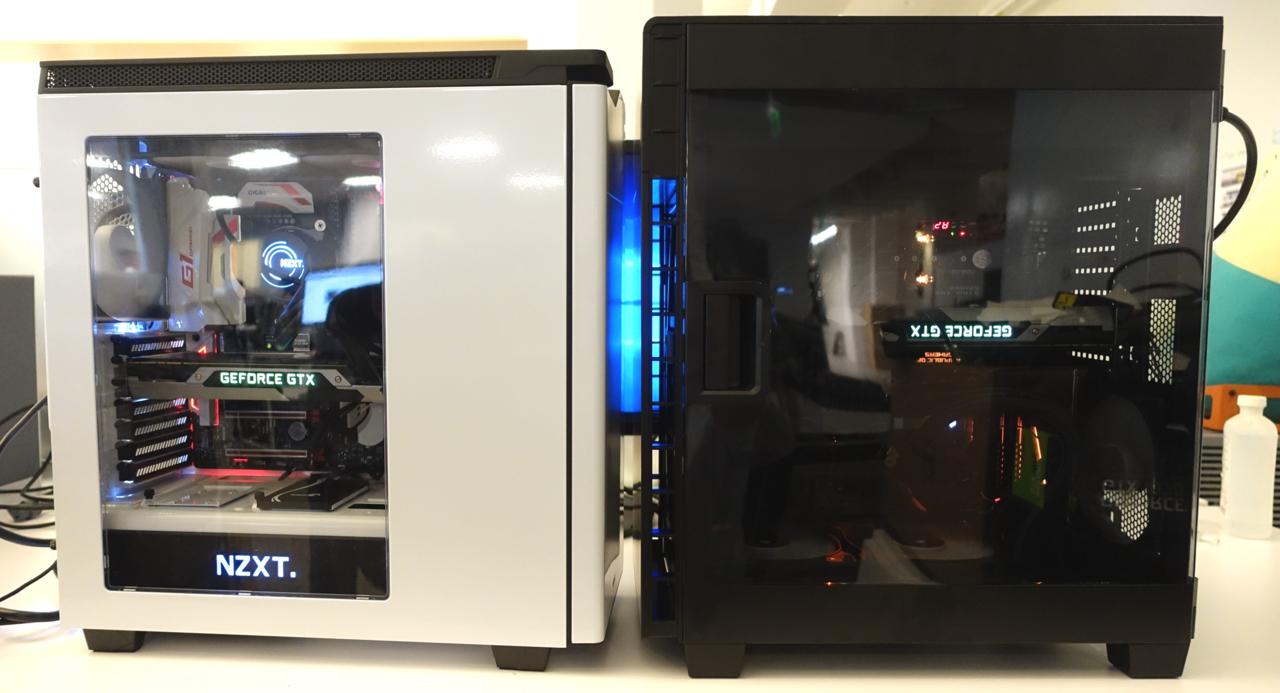
Below you’ll see 23 benchmarks that encompass a wide variety of scenarios that include real-world tests, synthetic benchmarks, and games. To get the most mileage when it comes to games, I used titles that were CPU-intensive. Strategy games or titles with sophisticated AI/physics tend to be better examples of CPU-bound games. Another interesting thing to note is that games rely more on the CPU when graphics settings are set to low, so I ran the games at their respective lowest presets (When you dial up the graphics, the games will often lean more on the GPU). Having said that, using a really expensive CPU to run games at their lowest settings isn’t quite representative of a real-world scenario, so I also ran them running max settings as well. With the methodology out of the way, let’s get onto the tests.
3D Rendering Benchmarks
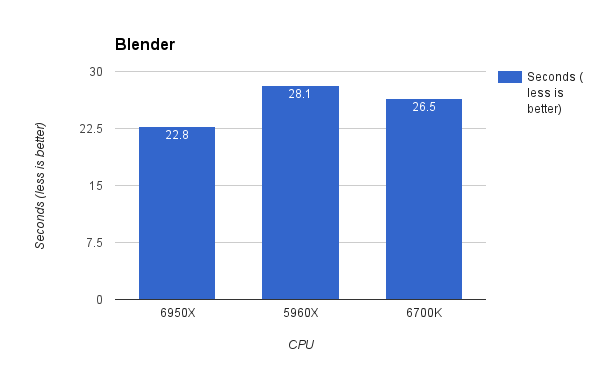
Blender is an open-source 3D graphics and animation program. The program likes cores and we ran a short benchmark in which we used our rigs to render a 3D model of a flying squirrel. All three of our setups were able to complete the render in under 30 seconds. The 6950X came out on top here rendering the image in under 23 seconds. Interestingly enough, the 5960X came in last place by just a hair. It looks like Blender values both core count and frequency.
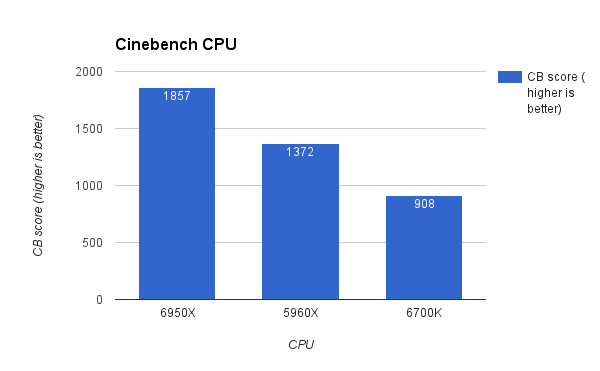
Cinebench is another 3D animation program and it really loves cores. Intel told me that from its internal tests, the 6950X would run 35 percent faster than 5960X and that the 10-core CPU was up to 2x better than the 6700K. My own data here confirmed these claims with the 6950X performing exactly 35 percent better than the Haswell-E chip. Compared to the 6700K, it performed slightly even better than Intel claimed with a whopping 105 percent lead. This is pretty crazy and represents the largest performance gap in my entire suite of tests.

The Persistence of Vision Raytracer (POV-RAY) is a ray tracing program that is used for creating 3D graphics. The application also has a built-in benchmark and happens to love cores, as is evident in our test here. Even though it only has 25 percent more cores than the octo-core processor, its 32 percent more efficient here, which proves that not all cores are created equally. It also towers over the quad-core CPU with a 90 percent gap.
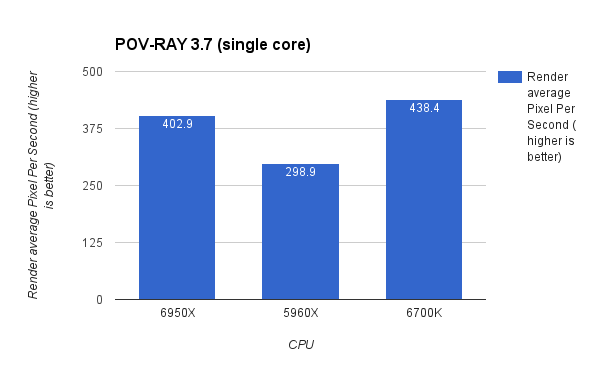
POV-RAY also features a single-core benchmark, and here, the 6700K’s faster 4.2GHz boost frequency gives it the upper hand over the 6950X by eight percent. On the bright side for the Broadwell-E chip, it does handily beat the Haswell-E CPU here by 35 percent, which shows Intel Turbo Boost Max 3.0 feature at play.
Synthetic Benchmarks
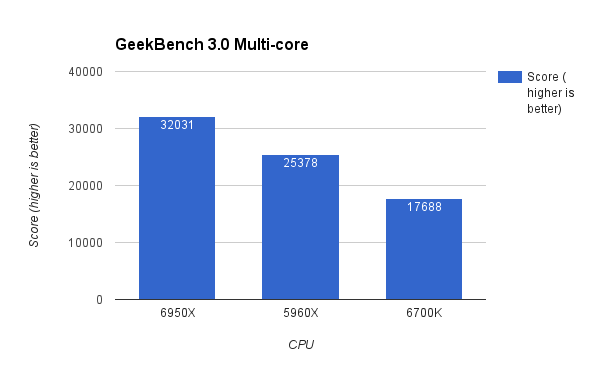
GeekBench 3.0 is a synthetic benchmark that works across a bunch of different platforms that include Windows, Mac, Linux, Android, and iOS. It has options for multi-core and single-core modes. Running GeekBench 3.0 in its multi-core mode yielded a 26 percent advantage for the 6950X over the 5960X. Compared to the four-core 6700K, it proved to be 81 percent better.
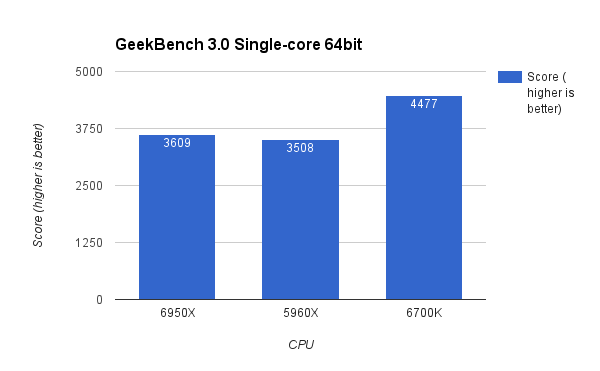
When running GeekBench 3.0’s single-core benchmark, the tides predictably changes in favor of the quad-core chip, which makes sense since the 6700K carries a zippier 4.2GHz turbo frequency. Interestingly, the 6950X outperforms the 5960X here despite carrying the same base frequency. This is most likely due to Intel’s Turbo Boost Max 3.0 kicking into action, which gives the Broadwell-E chip an extra performance oomph.
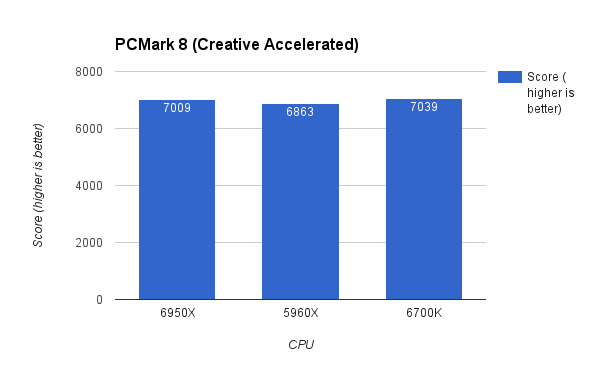
PCMark 8 is a synthetic benchmark which aims to simulate real-world tasks and its Creative mode presents its most taxing workload. We also ran the test with GPU acceleration, which leverages our PC’s graphics card for rendering work. This takes some stress off our CPUs and puts it on our GTX 980 GPU, but it’s also more indicative of a real-world scenario. As you can see from the results, this does flatten the performance landscape, with everything coming out about even.
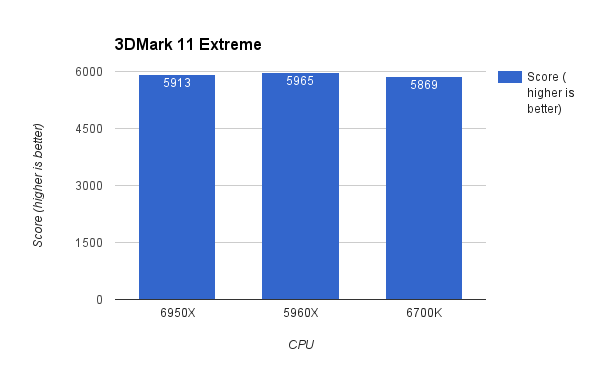
3DMark 11 is a popular synthetic DirectX 11 graphics benchmark, but I wanted to see what effect CPU has on the test. Evidentantly, from the numbers, it looks like it has little effect on the benchmark on the Extreme graphics settings, as these figures essentially represent a statistical tie.
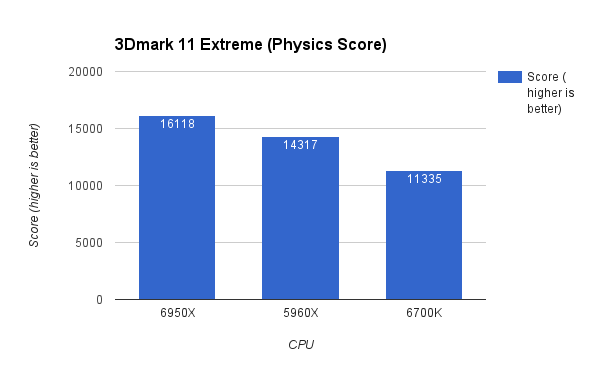
Looking at the physics score for the same test, which is heavily CPU-bound, we see that the 6950X clearly takes the lead with a 13 percent advantage over the octo-core processor and a much larger 42 percent advantage over the quad-core CPU.
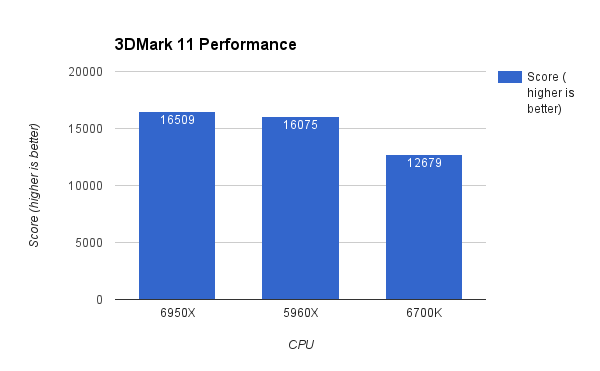
While scores were essentially tie under the 1080p Extreme settings, I also wanted to run the benchmark at the less GPU-intensive “Performance” mode, which renders multiple scenes at 720p. Performance mode leans more heavily on the CPU as a result. As you can see from the figures above, our data confirms this with the 6950X being able to enjoy a three percent lead over the 5960X and a larger 30 percent lead over the 6700K.
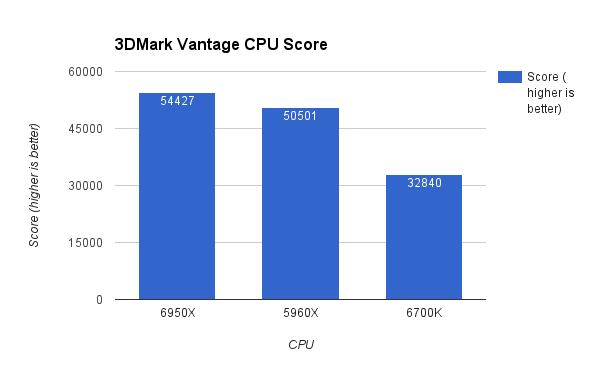
Whereas 3DMark 11 is more of a graphics test, its sister synthetic benchmark, 3DMark Vantage, calculates physics and acts as a CPU test. Here, the 6950X once again comes out on top. This time, with an eight percent lead over the 5960X and a whopping 66 percent advantage over the 6700K.
Video Encoding Benchmarks
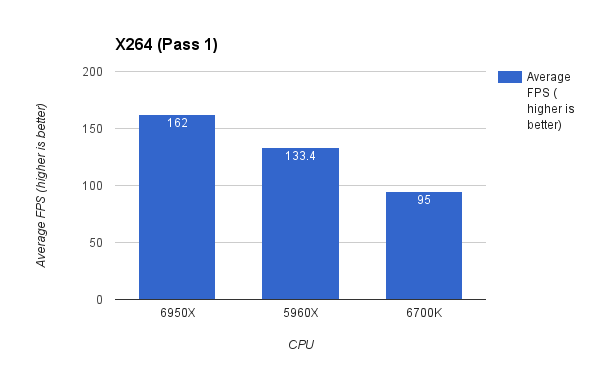
Tech ARP’s x264 benchmark is a demanding video encoding test that encodes a 1080p video clip and converts it into a high quality x264 video file. This particular test here represents the first pass of the video encode and it’s worth mentioning that x264 loves CPU cores. This is evident in our numbers with the 6950X holding a 21 percent lead over the 8-core 5960X and 71 percent over the four-core 6700K.
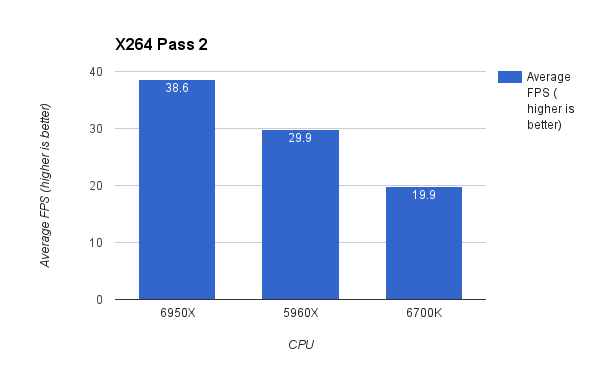
In x264’s second video encoding pass, the lead for the Broadwell-E chip only widens with it garnering a 29 percent gap over the Haswell-E CPU and a 94 percent gain over the Skylake processor.
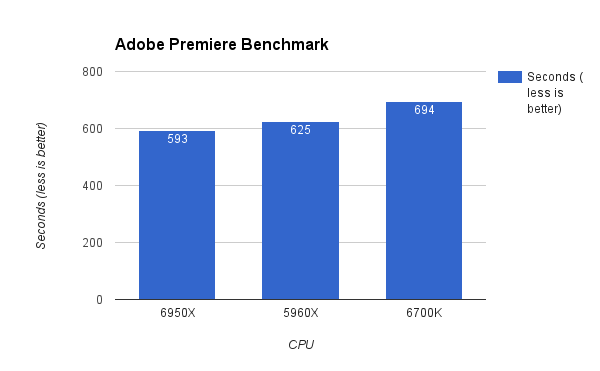
With such a high-end CPU, I wanted to makes sure that I had a real-world video editing test, so I worked with our video team to come up with a legitimate Adobe Premiere test that the video team might actually encounter. In the test, I encode three and a half minutes of raw 4K game capture footage, which amounts to 3.2GB, down to a 650MB MP4 file using the H.264 video compression standard. The end result is roughly Blu-ray quality footage. The scores you see represent encoding time in seconds, with less being better. While the 10-core 6950X definitively comes out on top here, being the only CPU to be able to encode the video in less than 10 minutes. It is a little disappointing that it’s only five percent faster than the octo-core CPU. Even the 15 percent advantage over the 6700K failed to blow our socks off.
Compression Benchmark
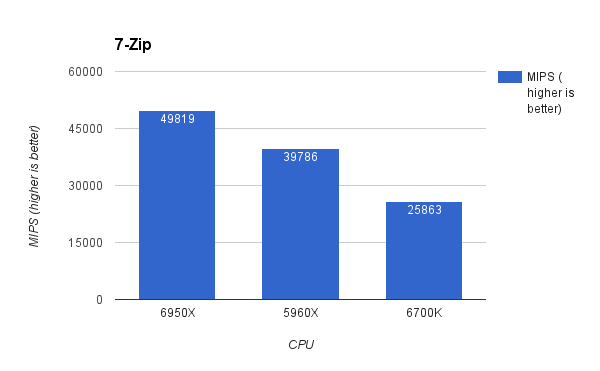
7-Zip is a popular, free tool for compressing and decompressing files for archival purposes. Like Winzip before it, you use it to zip and unzip files. Because compressing and decompressing files can be very CPU-intensive, it also has a built-in benchmark. 7-Zip also does a fantastic job leveraging CPU cores. It performs 25 percent better than the 5960X, which is a nice coincidence considering it has 25 percent more cores than the Haswell-E chip. It’s also a whopping 93 percent better than the 6700K.
Web Benchmark
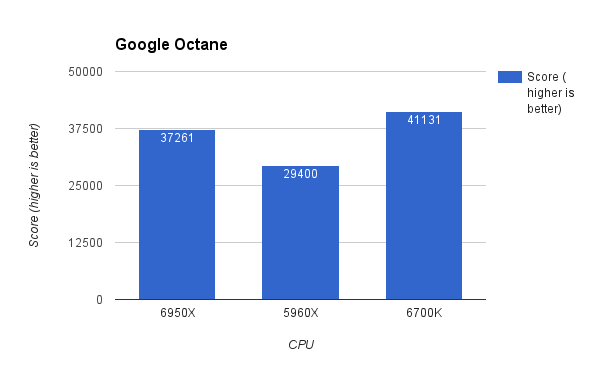
Google’s Octane 2.0 benchmark is a JavaScript benchmark that stress tests your web browser simulating demanding web applications. It’s actually a really lightweight benchmark that is perhaps better suited for laptops and tablets, but I still wanted to see how some enthusiast CPUs would handle it. It looks like the benchmark values speed over sheer number of cores here, with the 6700K coming out on top.
Game Benchmarks
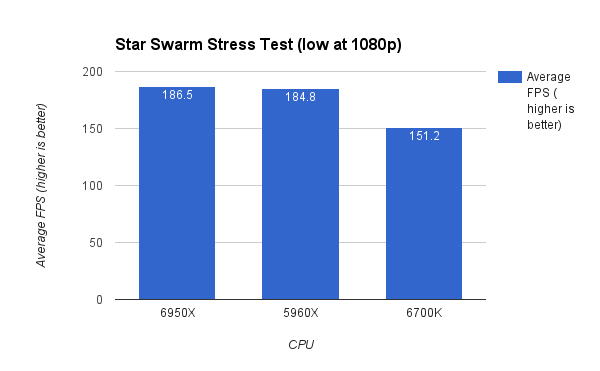
Developed by Oxide Games, the Star Swarm Stress Test is a real-time tech demo. It’s one of those rare game tests that seems to love CPU cores. I’m running it here at the lowest settings first to take weight off of the GPU so that it leans more on the CPU. While the 6950X comes out on top here, the sweet spot seems to be around eight-cores, since the 5960X lags just a percent behind.
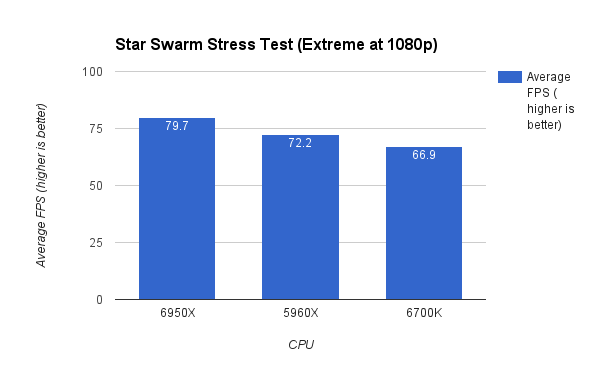
Surprisingly, when I crank settings to the max in the Star Swarm Stress Test, the 6950X maintains its lead, definitively so against even the 5960X this time around with a 10 percent advantage. While the overwhelming majority of games don’t effectively use more than four cores, the Star Swarm Stress Test is an example of what’s possible if developers tap into the power of multi-core CPUs.
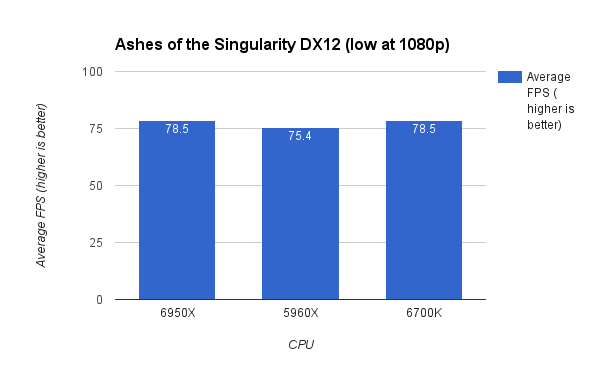
Because Oxide Games’ Star Swarm Stress Test took advantage of multi-core CPUs so well, I was interested to see if it would transfer over to the company’s recently-released RTS Ashes of the Singularity. Looking at the data, this doesn’t appear to be the case. Even on the lowest settings, where the game leans more heavily on the CPU, the ten-core and four-core tie.
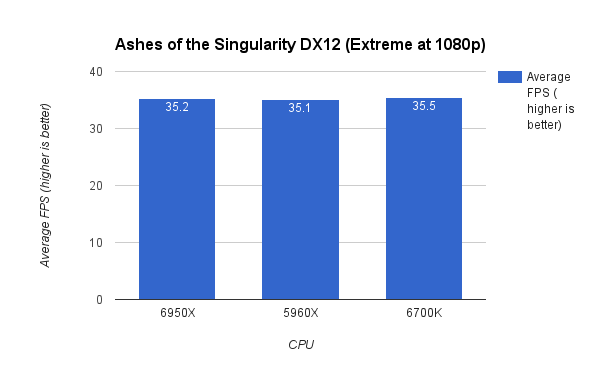
The story largely remains the same when I crank the game’s settings to high, where it leans more on the GPU. Here, all three CPUs garner a 35 average FPS.
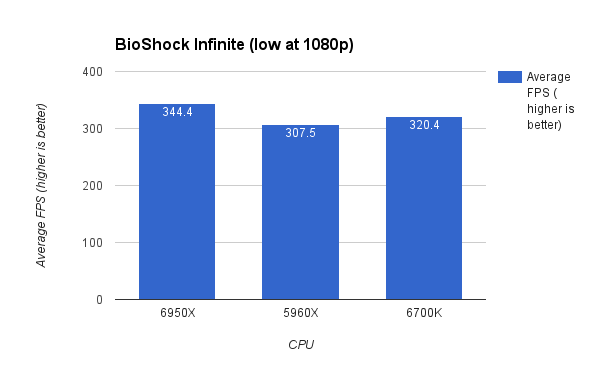
Irrational Games’ BioShock Infinite is a game that likes cores. Running the game at its lowest settings reveals a seven percent lead for the 6950X over the 6700K. Interestingly, the 6700K’s fewer, but faster cores, were able to give it the win over the eight-core 5960X here.
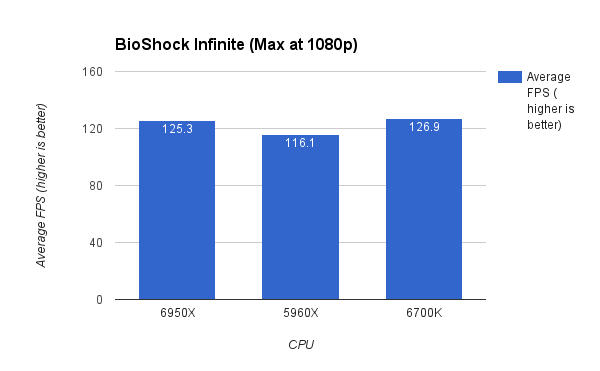
When we crank things to the max at 1080p in BioShock Infinite and the load is placed more on the GPU, the 6950X loses it lead, with the Broadwell-E and Skylake chips coming to a statistical tie.
VR Benchmark
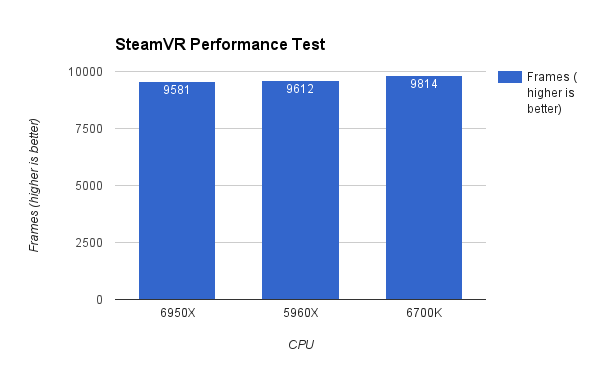
There aren’t very many VR benchmarks out there, but there is Valve’s SteamVR Performance Test. While VR can be quite CPU-intensive, especially when you take into account the additional processing power that head-tracking requires, the SteamVR Performance Test unfortunately does not account for head-tracking. It is therefore much more GPU-heavy. In my data set here, it’s very similar across the board, with the 6700K holding a two percent advantage over the 6950X.
Temps and Overclocking
You might now know how the 6950X performs, but how does it handle the heat? At idle with our setup, which includes a Corsair Carbide 600C full-tower case with three case fans, and Corsair’s H115i water cooler, our CPU maintained a cool 27 degrees Celsius temperature with a core voltage of .76 volts. Using the demanding x264 benchmark to stress test the CPU, our voltage went up to 1.24 volts with our temperature rising to 67 degrees C. This is still relatively cool and suggest some wiggle room for overclocking.
For the enthusiast overclocker, Broadwell-E has a wealth of intricate overclocking options that include per core overclocking, AVC ratio offset, and VCCU control, which allows you to adjust the CPU’s power ring.
While many of those features seem tailor made for extreme overclockers that are bent on setting overclocking world records, I simply went into the BIOS and overclocked all 10 cores to 4.3GHz and got the CPU running stable with a core voltage of 1.39 volts, which is admittedly quite high. This represents a 19 percent overclock across all cores compared to the chip’s default 3.5GHz boost clock. I then re-ran and completed the lengthy and grueling x264 benchmark, and saw a 15 percent performance boost. Since every chip overclocks differently (even CPUs within the same SKU), your overclocking mileage may vary.
Conclusion
Intel’s Core i7-6950X isn’t for everyone. Yes, it’s crazy fast and Intel’s best prosumer chip to date, but at $1,723, only professionals should really get it. With $1,700, you could build a fantastic gaming rig with a 6700K CPU with a nice graphics card (or two) that will max out 1080p games, and have plenty of cash left over to spare.
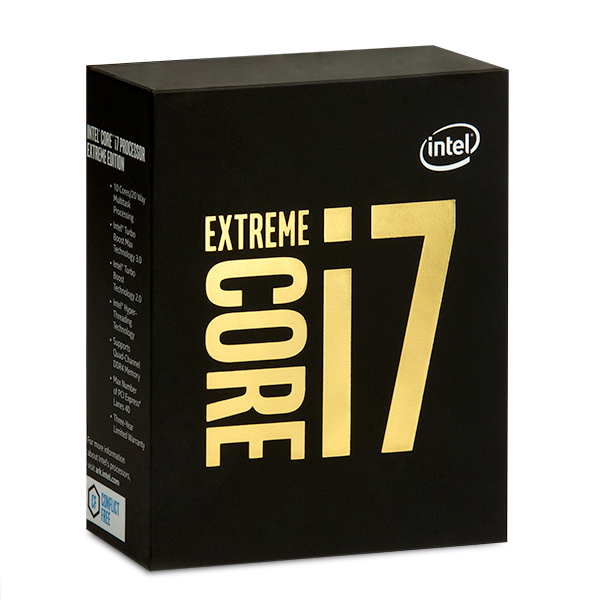
Why is it so darn expensive? With AMD’s CPUs catering towards the low-to-mid tier, you could make the argument that Intel has no competition at the top of the performance heap (this could potentially change with AMD’s Zen CPUs on the horizon, however). To be fair, the 6950X is an amazing chip and is more than twice as fast as Intel’s leading quad-core chip in some cases, which is crazy, but if all you intend to do is game, than a quad-core CPU will do you fine.
Best prosumer chip to date.
If you game and do some demanding productivity work on the side, then a six or eight-core CPU might be up your alley. If you like to game and are constantly editing video, rendering 3D models, or are perhaps a professional Twitch streamer who has to handle megatask workloads all the time, than the 6950X is a dream chip come true.
Got a news tip or want to contact us directly? Email news@gamespot.com
Join the conversation